How to clean mounting foam from clothes?
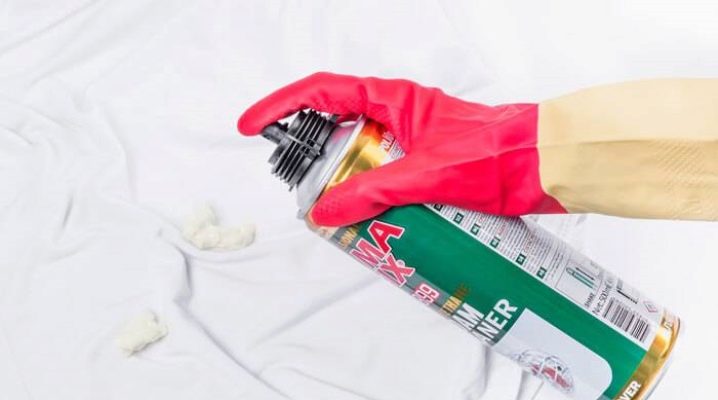
Polyurethane foam is a building material that performs an important function in the implementation of construction and repair work. This polyurethane sealant is essential for sealing gaps, seams and voids. It has many advantages and in some cases is simply irreplaceable. But when this material gets on clothes, there are serious problems associated with its removal from one or another type of fabric.
However, it is difficult to call a thing with foam contamination hopelessly damaged, since there are some cleaning methods that you can try to eliminate this kind of stain.
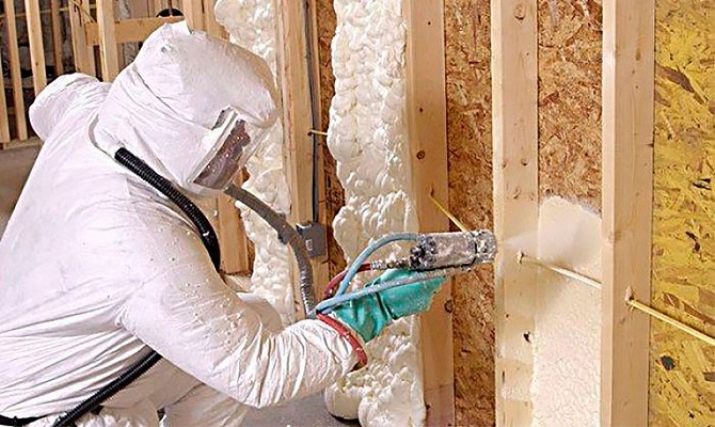
Features of pollution
Polyurethane foam is quite popular in renovation and construction work because it bonds very strongly to the material. This explains the difficulties that arise when removing the sealant from clothing fabrics. The resulting stain cannot be removed by machine or hand washing.
A reasonable solution to prevent the appearance of this type of contamination on clothing is to purchase, in addition to the mounting foam, a solvent designed to instantly and effectively deal with the adhesive mass that has fallen on the item.


In the absence of such a tool, it is possible to clean clothing from building material using home remedies. The likelihood of cleaning up such contaminants with improvised means will be much less, and the time costs will be greater. However, it is impossible to delay the removal of these stains, since the sealant hardens rather quickly. (within 12 hours) and sticks to the tissue, penetrating deeply into its fibers, which will further create even more difficulties in its removal.

The success of the result and the difficulty of achieving it, associated with the removal of stains from building material, are due to the promptness of the response - cleaning measures must be taken immediately, until the foam composition has had time to go into a frozen state.
What can be washed?
Special cleaners or products that are always at hand help to clean the product from mounting foam. The cleaning process will be much easier if the stain is fresh and not hardened.
To cope with stains of varying complexity, it is recommended to use the following tools:
- store-bought foam cleaner;
- foam solvent;
- dimexide;
- mixture of gasoline and stain remover;
- a mixture of white spirit and stain remover;
- acetone;
- nail polish remover.

The listed products emit toxic substances, therefore, before opening the package, it is necessary to protect the respiratory system by wearing personal protective equipment. In addition, the room should be regularly ventilated.
The use of improvised means found at home can adversely affect the fabric of clothing on which part of the mounting foam has fallen. Removing stains using home cleaning methods is much more difficult and time consuming.There is a high probability of damage to the surface of clothing and dissolution of fabric paint. Therefore, it is imperative to test them on the wrong side of the clothing, hidden from prying eyes.
The absence of a cleaner should not prevent clothes from being cleaned. If a special tool has not been previously purchased, it is not worth wasting time looking for it in stores and buying it. In this case, every minute is precious, so instead of carrying out these actions, it is better to use improvised means.


Effective cleaning methods
Unfortunately, the pollution from the polyurethane foam is not always possible to notice in time. The greatest difficulties arise when removing old stains formed from a frozen building composition. It seems that your favorite jacket, comfortable trousers or fashionable jeans are hopelessly damaged and will have to be thrown away. However, the issue can be resolved by using affordable products available at home or special solutions sold in hardware stores.
You just need to know the tools and how to use them correctly. With the appropriate knowledge and skills, things can be safely cleaned and returned to their original form.
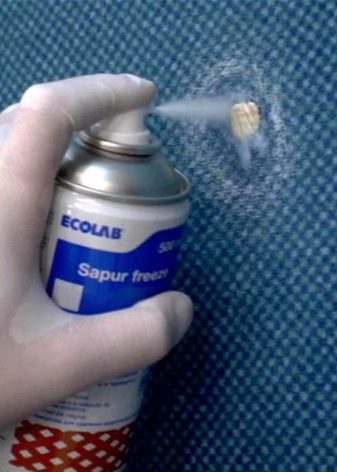

There are many means and methods for effectively cleaning contaminants from mounting foam. The most common are:
- Spatula (knife), laundry detergent (laundry soap), rags (cotton disk or napkin), special foam cleaner. Among special means, this substance is very popular because it has an affordable price and wide availability. The way to use it is to clearly perform the following sequential steps:
- Remove the foam cap with a spatula.
- Moisten a rag in a cleaning solution and apply it to the area to be treated with point movements. When a liquid substance enters the stain, it can be easily and safely removed from the fabric.
- Wash the product with powder and rinse.


- Knife (spatula), cotton swab, brush with hard bristles, laundry detergent (laundry soap), dimexide. This is an affordable medical product used for external use. It refers to antiseptics. Dimexide in the form of a solution or concentrate can perfectly remove stains that appear from building material and even glue on the surface of things. Mode of application:
- remove the foam cap from the surface of the product with a knife;
- swab apply dimexide with a thick layer on the frozen foam;
- wait half an hour for the stain to dissolve under the influence of the product;
- brush off traces of foam;
- to wash things with powder;
- after finishing the cleaning procedure, rinse the item.


- Thinner, hard sponge (brush with hard bristles). This tool and its action is similar to a cleaner. The difference is getting a more effective result: its action is much faster, and the surface is much cleaner. Mode of application:
- remove the foam cap;
- apply the solvent to the stain and wait a quarter of an hour to soften it;
- wipe off the remaining foam with a brush or sponge;
- if such a need arose, the procedure must be repeated;
- at the end of the cleaning process, rinse the item in warm water.
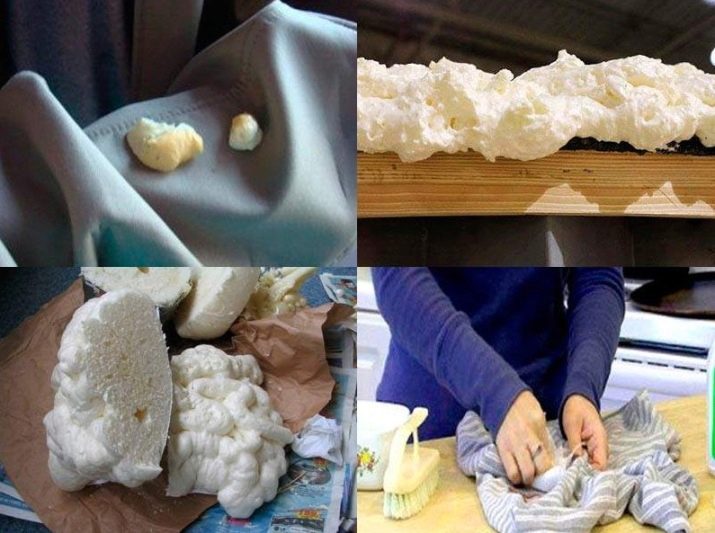
- Gasoline, stain remover, spatula. Means are recommended to be used sequentially.It should be taken into account that the use of these products leads to the risk of paint erosion and the formation of color streaks in the area that has been contaminated. Therefore, in this case, it is simply necessary to test this tool on an inconspicuous area of \u200b\u200bthe thing. Mode of application:
- spatula to remove pieces of foam;
- moisten the traces of foam abundantly with gasoline to ensure their soaking and subsequent easy removal;
- depending on the severity of the contamination, wait the right time (if the stain has an average complexity of contamination, wait 30 minutes);
- after the specified time, treat the fabric with a stain remover, strictly following the instructions on the product packaging;
- wash the treated area and rinse.

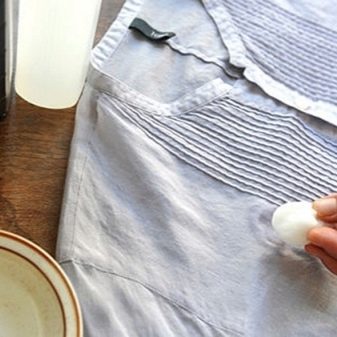
- White spirit, stain remover. When using these chemicals, they should be tested on a small piece of fabric to prevent possible deterioration or discoloration of the fabric. Way to apply:
- saturate the stain with plenty of white spirit;
- wait half an hour;
- Treat the stained area with a stain remover. Before using such a chemical, you must read the instructions on its packaging.
- Wash product and rinse.
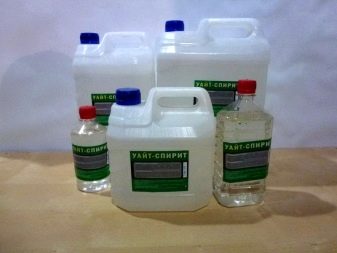

- Nail polish remover, cotton buds. It is recommended to use a fluid that does not contain oil. It will be able to ensure the removal of even old stains. Mode of application:
- gently apply the product to the surface to be treated;
- remove the building composition from clothes with cotton swabs.

- Vegetable oil, washing powder, brush. Fats cope with pollution from varnish, coloring matter and polyurethane foam. Mode of application:
- clean the foam composition from the treated area;
- thoroughly soak the stain with warm vegetable oil;
- wait a few minutes (no more than 5) for the pollution to absorb the oil;
- then pour washing powder on the oiled area, rubbing it until foam is obtained - this will help wash off the surface layer of the building substance. If necessary, add a little water;
- gently clean the fabric with a brush;
- wash the treated area in warm water, to which the powder is added.


If the above remedies and how to use them did not help to cope with pollution, it may be worth trying two more methods of cleaning:
- Freeze. It is recommended to place the thing subject to contamination in a bag made of polyethylene so that the stain does not touch clean areas and is on the outside. It is necessary to put the bag in the freezing chamber and wait a certain time required for the foam to completely solidify. Frozen foam should be carefully scraped off with a knife. The remaining small marks are cleaned with a stain remover or nail polish remover. After carrying out this cleaning method, you need to wipe off the remaining foam and rinse the product.


- Light from the sun. This type of processing requires a lot of time. The use of an ultraviolet lamp will help speed up the process. This cleaning method is suitable for fabrics characterized by density and a high degree of resistance to adverse effects. We are talking about jeans, a jacket and other clothes. The properties of mounting foam are used for internal construction work, so the influence of the sun is detrimental to it. This causes her rather rapid aging.Using this property as a fabric stain remover ensures that the desired result is obtained. The area of fabric that is subject to contamination should be placed in an open area that is under direct sunlight.
A long time is expected, involving a period of several days. The stained fabric needs to be rumpled periodically so that the stain disappears faster. One of the previously discussed means can handle the remnants.

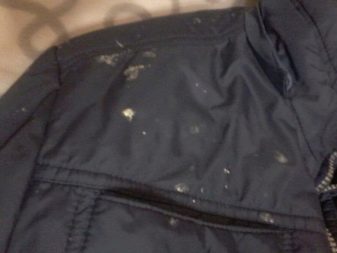
Removing old stains
Foam that has had time to harden has a high level of strength and water resistance, and it can also withstand adverse environmental influences.
To combat pollution resulting from the drying of a semi-liquid mass, it is recommended to use special tools.
A lot of products have been produced that can easily clean the foam composition from different types of fabrics. Such cleaners are sold at an affordable price in specialized stores. They can be used to clean tools and clothing. The most requested of them are:
- Liquid for cleaning the mounting gun. This tool is being developed by companies that produce the mounting foam itself. This substance instantly removes traces of foam that have not had time to dry on trousers and a jacket. It is recommended to remove fresh or very slightly dried foam from the fabric with a spatula, and treat the absorbed residue with a chemical from a can. The liquid can also remove old contaminants, but its action will not be effective enough. The hardened foam should be soaked and then scrubbed with a brush with hard bristles.
After cleaning clothes, it is recommended to wash them in a solution of powder and water.


- Special solvent designed for dried foam. To soften the hardened sealant, you can buy a special solvent that has a powerful effect. However, its price will be higher than the cost of fluid for pistols. Hardened foam should be cut off with a knife blade. Extreme caution and utmost accuracy will help prevent violation of the integrity of the canvas and the formation of holes in a contaminated place. After that, leave the thing with the applied product for the time indicated on the instructions (about a quarter of an hour). The soaked mass must be cleaned from the surface of the clothing. To achieve a more effective result, this procedure can be repeated.
To avoid possible damage to the fabric from exposure to the chemical, testing it on a small area of \u200b\u200bthe garment from the wrong side will help.


- Aerosol cleaner. Before using it, it is recommended to shake the liquid container gently, then the process of direct spraying is carried out. A knife will help to get rid of the foam that protrudes above the surface before cleaning, and residual contamination should be sprayed with a product. A clean cloth should not be exposed to the solvent. After a quarter of an hour, the contaminated place must be wiped off with a foam rubber sponge, and the product itself should be washed with water to which soap has been added. Aerosols are used to remove both fresh and already dried foam.
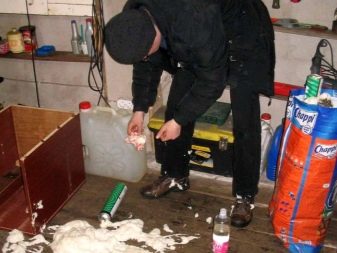



If none of the listed types of cleaning was successful and the stain remained in the same place, you can resort to the only option to help prevent clothing from being thrown out - to embroider or applique on the damaged area.
Helpful Hints
There are many methods that reveal the essence of the safe removal of building dirt from clothing, but we must try to make every effort to ensure that such dirt simply does not appear. Then you don't have to spend time cleaning such difficult stains, nor money to buy chemicals specially designed to remove contaminants from building material.
To avoid getting mounting foam on your clothes, taking into account the following tips will help:
- Protective clothing. It is recommended to wear special gloves and suits suitable for working with building mortar. Old clothes are also suitable, which it is not a pity to use for such a purpose.
- Tool. Cartridges and pistols provide the necessary dosage of foam. Its excess will not flow out of the tool.
- Workplace organization. Ample and comfortable space will help to avoid accidental contact of the semi-liquid mass on the surface of the clothing. Foreign objects must be removed immediately so that they do not interfere with the flow of the workflow.
- The right technology. It is advisable to pre-treat with water the surface with which the foam will adhere. This improves the quality of the bond, and the building composition will not fall out of the slots onto the floor or clothing.
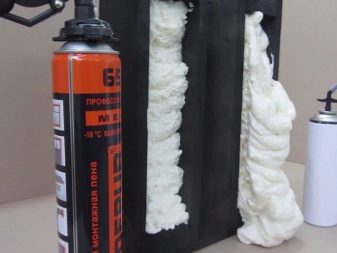

When working with toxic products at home, you must follow the safety rules:
- it is necessary to ensure regular ventilation of the room;
- it is recommended to use rubber gloves that can prevent chemical burns;
- personal protective equipment will prevent the ingress of toxic substances on the skin and mucous membranes;
- be sure to tie a scarf on your head or put on a hat;
- do not spray aerosols near open flames /
It is forbidden to spray chemicals in close proximity to varnished surfaces - this can lead to their damage.


For information on how to remove mounting foam from clothes, see the following video.




























